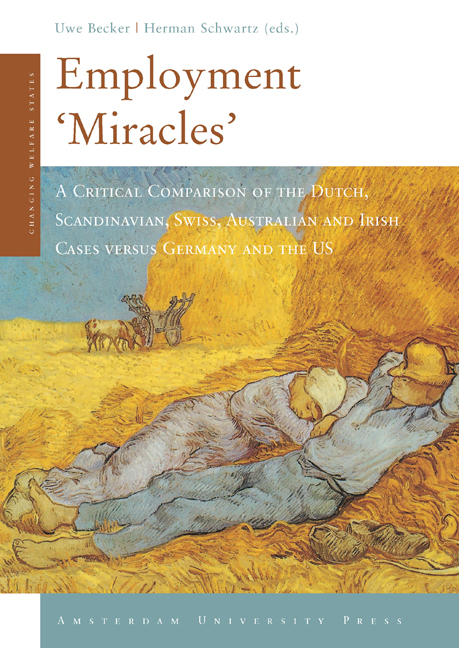 Employment 'Miracles'
Employment 'Miracles' Book contents
- Forntmatter
- Contents
- Preface
- 1 Introduction: Miracles, Mirages and Markets
- 2 The Dutch Model: Magic in a Flat Landscape?
- 3 Employment and Unemployment in Denmark and Sweden: Success or Failure for the Universal Welfare Model?
- 4 The Evolution of the Finnish Model in the 1990s: From Depression to High-Tech Boom
- 5 The Swiss Miracle: Low growth and high employment
- 6 Recasting the Story of Ireland’s Miracle: Policy, Politics or Profit?
- 7 The Australian Miracle: Luck, Pluck or Being Stuck Down Under?
- 8 Last Year’s Model? Reflections on the American Model of Employment Growth
- 9 The German Contrast. On Bad Comparisons, Special Circumstances, Luck and Policies That Turned Out to Be Wrong
- 10 Conclusion: The Importance of Lucky Circumstances, and Still the Liberal-Social Democratic Divide
- Bibliography
- Contributors
- Index
7 - The Australian Miracle: Luck, Pluck or Being Stuck Down Under?
Published online by Cambridge University Press: 15 January 2021
- Forntmatter
- Contents
- Preface
- 1 Introduction: Miracles, Mirages and Markets
- 2 The Dutch Model: Magic in a Flat Landscape?
- 3 Employment and Unemployment in Denmark and Sweden: Success or Failure for the Universal Welfare Model?
- 4 The Evolution of the Finnish Model in the 1990s: From Depression to High-Tech Boom
- 5 The Swiss Miracle: Low growth and high employment
- 6 Recasting the Story of Ireland’s Miracle: Policy, Politics or Profit?
- 7 The Australian Miracle: Luck, Pluck or Being Stuck Down Under?
- 8 Last Year’s Model? Reflections on the American Model of Employment Growth
- 9 The German Contrast. On Bad Comparisons, Special Circumstances, Luck and Policies That Turned Out to Be Wrong
- 10 Conclusion: The Importance of Lucky Circumstances, and Still the Liberal-Social Democratic Divide
- Bibliography
- Contributors
- Index
Summary
Introduction
During the 1990s “economic miracles” in Ireland, Denmark and the Netherlands attracted considerable attention. All three countries reduced measured unemployment and reversed deleterious fiscal and current account deficits dating from the 1970s to a greater extent than their larger European neighbours. Analysts looking for policy lessons that might be applicable to the employment and growth malaise in those larger European economies were particularly drawn to the two “nice”, that is, more social democratic, examples of change, or to the superficially high-tech dynamism of Ireland. All this attention obscured another equally interesting miracle story playing simultaneously in the southern hemisphere: Australia.
This lack of attention is curious for three reasons. First, the Australian economy in GDP terms is roughly equal to the combined economies of Sweden, Norway, and Finland. Second, the scale and direction of change in Australia seems to be much more the product of intentional strategic action – pluck – than of endogenously generated change consistent with prior logics of appropriateness or of simple good fortune – stuck or luck. Analytically, Australia should thus have been a more interesting place to learn lessons for those seeking policy solutions for larger countries, because it is hard to see how changes deriving from local logics of appropriateness can be transferred easily. Finally, Australia is one of the few OECD economies besides the USA and Ireland that experienced productivity growth substantially above both its own historical long-term trend in the 1990s and the OECD average. This occurred despite the potentially adverse consequences of the financial crisis in Asia, the location of Australia's largest markets.
In Australia, unemployment fell even while participation rates rose substantially; fiscal deficits gave way to surpluses; and a substantial shift in export profile occurred even though the current account deficit remained stubbornly high. Australia's employment performance in the 1980s was the best in the OECD. Australia created jobs at roughly twice the OECD average rate – a 25 percent expansion – despite rising labour force participation (reflecting strong population growth; see Figure 7.1) that caused the labour force to grow 1.9 percent annually on average 1985 to 2000.
- Type
- Chapter
- Information
- Employment 'Miracles'A Critical Comparison of the Dutch, Scandinavian, Swiss, Australian and Irish Cases versus Germany and the US, pp. 157 - 182Publisher: Amsterdam University PressPrint publication year: 2005


